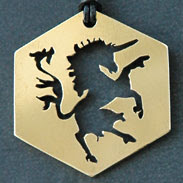I have also had a long interest in cultural differences, how words translate, how people express themselves through art and other means of communication, and the day to day interpersonal differences and similarities. With all of that combined with my interest in the Celts and Picts before them it was only natural that I would end up creating pieces in the Ogham alphabet. Through research I found out quite a bit.
 The Ogham Alphabet:
The Ogham Alphabet:Sometimes referred to as the "Celtic Tree Alphabet", Ogham was used between the 4th and 7th centuries AD in Ireland, Scotland, Wales, and England. The initial alphabet consisted of 20 characters with a few more complex characters being added later. The letters were formed by combination of short lines on and at either side of a middle line called a "flesc". With a vertical flesc words are read from bottom to top or right to left with a horizontal flesc.
Although surviving traces of Ogham were inscribed on stone it was probably more commonly inscribed on sticks, stakes, and trees to mark boundaries. There is also evidence from early Irish sagas and legends that indicates Ogham was used for short inscriptions on wood or metal used to relay messages (some cryptic in nature or for magical purposes) or to denote ownership of the object. There is also evidence that suggests that Ogham may have been used to keep genealogy records, numerical tallies of property, and business transactions.

Of the 400-500 remaining inscriptions a handful have been found featuring Ogham along with the Latin alphabet, most of the inscriptions are in an archaic form of Gaelic and Pictish.
Each of the Ogham pendants I have made started with an English word I thought would be a good talisman or a word in English that was requested. From there I set to translating each word into Gaelic cross referencing the translation and meaning of each word with at least 3 sources. Once I was satisfied with the correctness of the translation I then translated the resulting Gaelic word into the Ogham alphabet to create the design for each pendant.
There are a couple of reasons I chose to translate the words into Gaelic before translating them into Ogham.
 The first is a matter of practicality, since I am using the original alphabet there are only 20 letters that correspond with the 26 letter English alphabet which would leave 6 letters to be approximated by phonetics. I did not like the feel of going that rout so I chose to use Gaelic which is a language that ties more closely to Ogham historically. The other reason is a bit more 'spiritual' in nature. The technique of using 'power words' to create an effect or draw an energy to ones life has been used for centuries. I have spent a lot of time thinking on this practice and realized that words do in fact have power but we don't often think much about the words we use every day. By stepping into another language we have to give active thought to what words mean and their consequences which creates an even greater amount of energy to the power of words we use as talismans.
The first is a matter of practicality, since I am using the original alphabet there are only 20 letters that correspond with the 26 letter English alphabet which would leave 6 letters to be approximated by phonetics. I did not like the feel of going that rout so I chose to use Gaelic which is a language that ties more closely to Ogham historically. The other reason is a bit more 'spiritual' in nature. The technique of using 'power words' to create an effect or draw an energy to ones life has been used for centuries. I have spent a lot of time thinking on this practice and realized that words do in fact have power but we don't often think much about the words we use every day. By stepping into another language we have to give active thought to what words mean and their consequences which creates an even greater amount of energy to the power of words we use as talismans.I am open and welcome to any thoughts you may have so please share. And if you have a moment please check out the Ogham pendants I have listed in my shop. I will be adding more as I get them finished and photographed.





I may have missed this in your description - do you have the traslation available for a person that buys one of the Ogham pendants?
ReplyDelete:-) WitchMom
One of these days I'll learn to spell too, lol.
ReplyDeleteWitchMom,
ReplyDeleteYa know, I didn't state that in my description above... But I do include a sheet with each order that has the word in Gaelic, which form of Gaelic it is (Irish or Scottish), the meaning/s for the Gaelic word, and information about the Ogham alphabet itself.
I really should add that info to my listings as well. Thank you for bringing that up.
Ash
I'm glad I was able to help :-)
ReplyDelete